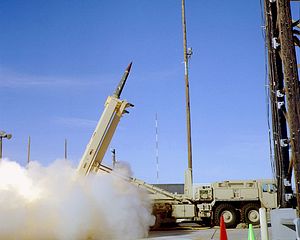On Friday morning, following months of bilateral talks, the United States and South Korea announced that the Terminal High-Altitude Area Defense (THAAD) system would be deployed in South Korea.
A press release from United States Forces Korea noted that the system would be deployed “in response to North Korea’s continued development of ballistic missile technology in contravention of six United Nations Security Council Resolutions.”
It added that the system “will contribute to a layered missile defense that would enhance the Alliance’s existing missile defense capabilities against North Korean missile threats.”
The decision to deploy THAAD has been cleared by both governments. Gen. Vincent K. Brooks, the current commander of U.S. Forces Korea, said the decision was an important one for the alliance, which has been in place since the end of the Korean War in 1953.
“North Korea’s continued development of ballistic missiles and weapons of mass destruction require the Alliance to take this prudent, protective measure to bolster our layered and effective missile defense,” he added.
Washington and Seoul have long been in talks over the deployment of the THAAD missile defense system.
In June, North Korea conducted a successful test of a Musudan (Hwasong-10) intermediate-range ballistic missile.
Additionally, North Korea regularly tests short-range SCUD missiles and other systems capable of striking South Korea.
China has notably expressed sharp concerns about the deployment of THAAD on the Korean peninsula, seeing the U.S. missile defense system as a threat to its own security.
Indirectly addressing Chinese concerns, the U.S. Forces Korea statement noted that “THAAD will be focused solely on North Korea.”
The Chinese foreign ministry, according to Reuters, asked the United States and South Korea to put a stop to the deployment of the system.
China hasn’t explicitly stated why it opposes the deployment of the system, but it is likely that AN/TPY-2 X-Band active electronically scanned array (AESA) radar systems accompanying THAAD batteries could improve U.S. intelligence, surveillance, and reconnaissance capabilities around the Korean Peninsula.
Speaking earlier this year, Chinese Foreign Minister Wang Yi said that the X-band radar capability “goes far beyond the defense need of the Korean peninsula.”
THAAD is exclusively capable of intercepting missiles in their “terminal” phase, as the platform’s name suggests. The terminal phase of a missile refers to its descent toward a target.
THAAD would not be capable of striking ballistic missiles overflying the Korean peninsula, for example.
North Korea will likely sharply protest the U.S.-South Korea alliance’s deployment of the advanced missile defense system.
The U.S.-South Korea joint announcement comes shortly after the United States, for the first time ever, named North Korean leader Kim Jong-un under new sanctions.
North Korea’s official KCNA news agency described the listing of Kim Jong-un under the new U.S. sanctions list as a “hideous crime” and said it would treat the move as a “declaration of war.”
The THAAD deployment decision could also inflame tensions between the United States and China in East Asia.
After North Korea’s latest nuclear test in January 2016, China acquiesced to new and unusually harsh sanctions at the United Nations Security Council (UNSC) against North Korea, under the requirements of UNSC resolution 2270.
The decision to go ahead with a THAAD deployment on the Korean peninsula could cause Beijing to defy Washington on continued cooperation against the Kim regime, including possibly the implementation of existing sanctions.
Though the historically close relationship between North Korea and China has been adrift in recent years, Pyongyang has shown recent signs of trying to improve bilateral ties.
































